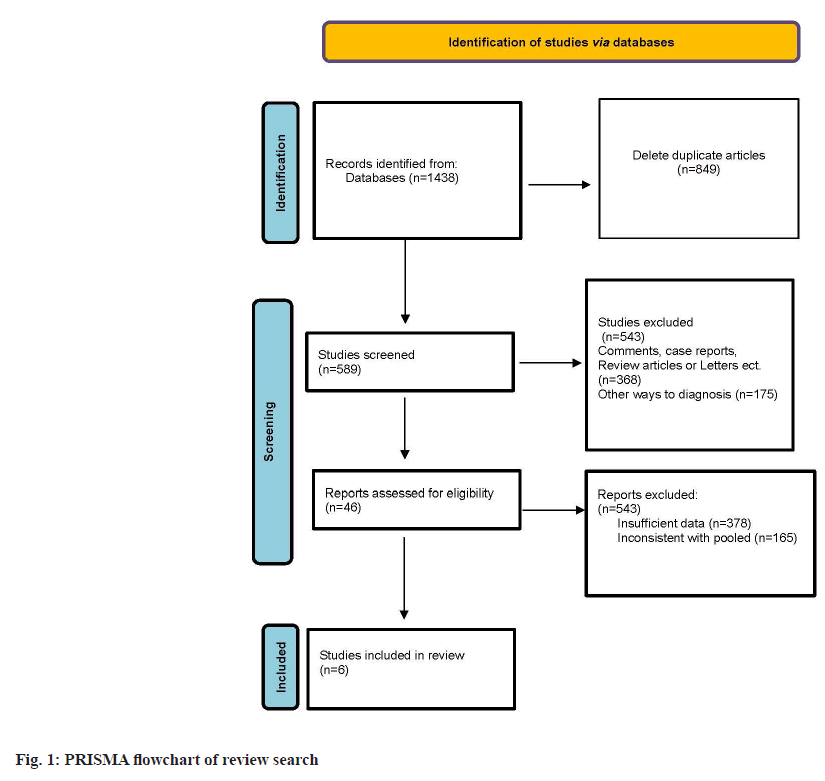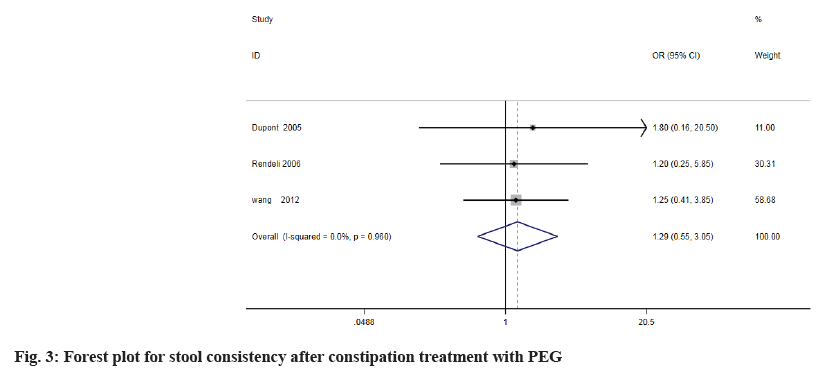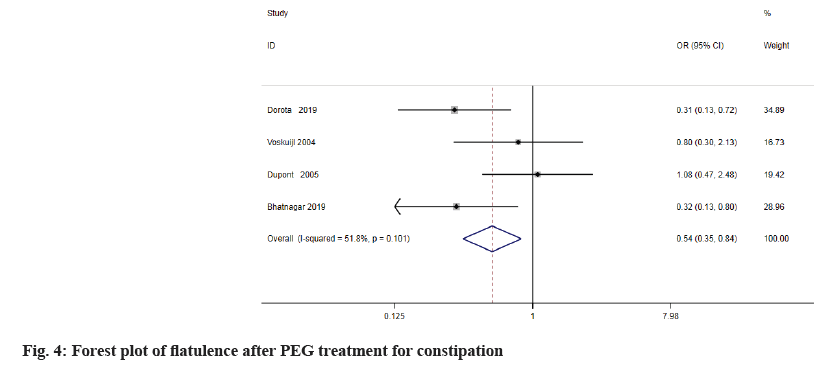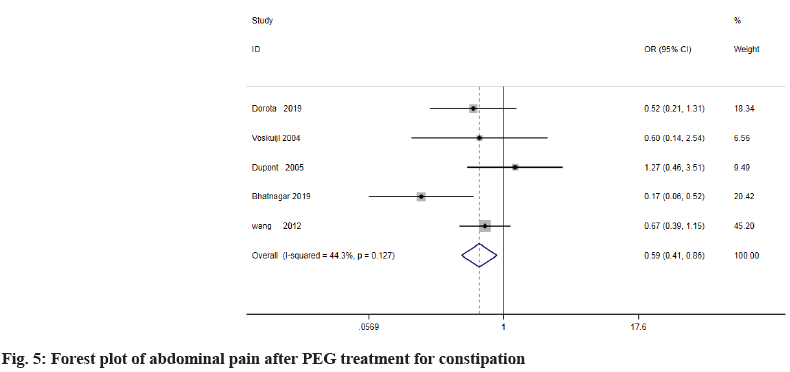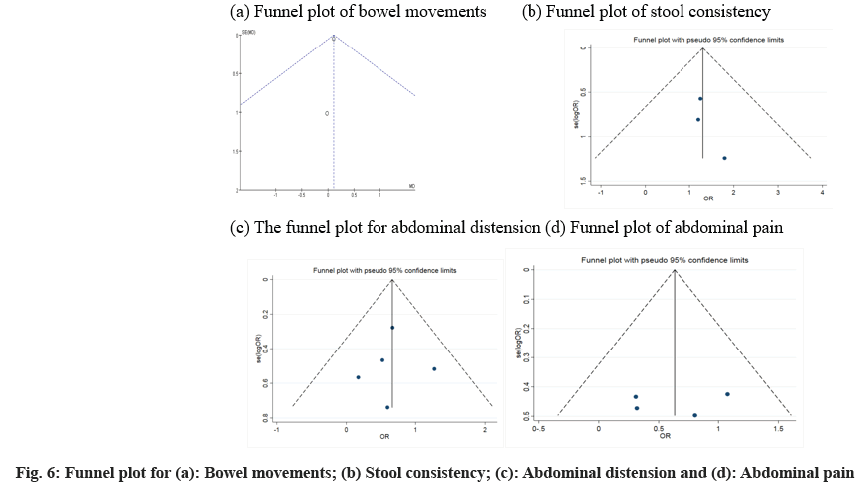- *Corresponding Author:
- B. Liu
Department of General Surgery, The Second Affiliated Hospital of Chengdu Medical College, China National Nuclear Corporation 416 Hospital, Chengdu 614000, China
E-mail: david1791560137@163.com
| This article was originally published in a special issue, “Transformative Discoveries in Biomedical and Pharmaceutical Research” |
| Indian J Pharm Sci 2023:85(4) Spl Issue “153-158” |
This is an open access article distributed under the terms of the Creative Commons Attribution-NonCommercial-ShareAlike 3.0 License, which allows others to remix, tweak, and build upon the work non-commercially, as long as the author is credited and the new creations are licensed under the identical terms
Abstract
Studies have shown that polyethylene glycol may be more effective than lactulose in certain cases. For instance, a study found that polyethylene glycol is more effective in treating constipation in children. In addition, although no safety issues were found for polyethylene glycol and lactulose in this study, attention should still be paid to the potential adverse reactions of these drugs. We searched PubMed, Web of Science and Embase for relevant studies published in English from database inception to April 2023. In this study, all statistical analyses were performed using Stata 15 software. The I2 statistic was used to assess heterogeneity between studies. A total of 6 articles with a combined sample size of 657 were included in the final analysis. The meta-analysis indicated that polyethylene glycol treatment was equally effective compared to lactulose in terms of bowel frequency, with a pooled treatment effect of 4 3 % (95 % CI 0.34-0.52). Significant heterogeneity was found among the studies included for this analysis (I2=99 %; p<0.001). Polyethylene glycol on fecal consistency was 1.29 (95 % CI 0.55-3.05). There was no heterogeneity among the studies used in this analysis (I2=0 %; p=0.96). The treatment effect of polyethylene glycol on bloating and flatulence was 0.54 (95 % CI 0.35-0.84). There was mild heterogeneity among the studies used for this analysis (I2=51.8 %; p=0.101). The treatment effect of polyethylene glycol for abdominal pain was 0.59 (95 % CI 0.41-0.86) compared to lactulose. There was no heterogeneity among the studies used for this analysis (I2=44.3 %; p=0.127). Polyethylene glycol for abdominal pain was 0.59 (95 % CI 0.41-0.86) compared to lactulose. There was no heterogeneity among the studies used for this analysis (I2=44.3 %; p=0.127). This study suggests that both polyethylene glycol and lactulose have equally good efficacy in treating constipation and can be used as alternative medications.
Keywords
Lactulose, polyethylene glycol, meta-analysis, polyethylene glycol, constipation
Constipation refers to a common condition of difficulty in passing stools or having fewer bowel movements, often accompanied by discomfort such as bloating and abdominal pain[1,2]. It is estimated that about 14 % to 20 % of adults worldwide suffer from constipation, with higher incidence rates in females, about twice that of males[3]. The symptoms of constipation severely affect patients' quality of life and can lead to a series of complications, such as anal fissures, hemorrhoids, and even intestinal obstruction[4]. Therefore, the treatment of constipation has important clinical significance. The treatment methods for constipation include medication, non-pharmacological treatment and surgical treatment. Among them, medication is the most commonly used method. Commonly used drugs include osmotic laxatives, saline laxatives, stimulant laxatives, lubricants and so on[5-8]. However, these drugs have various side effects, such as diarrhea, abdominal pain and long-term use may lead to drug resistance. Therefore, it is necessary to find a safer and more effective treatment method.
Lactulose is widely used in the treatment of constipation. It is a non-absorbable oligosaccharide that produces an osmotic effect in the intestine, promoting the entry of water into the intestine, softening stools, increasing bowel movements and relieving constipation symptoms[9,10]. However, lactulose's action depends on the colonic microbiota, and the fermentation process produces a large amount of gas, causing abdominal pain and bloating. Additionally, research has found that long-term use may lead to decreased efficacy[11].
In recent years, Polyethylene Glycol (PEG) has been suggested as an alternative medication for the treatment of constipation. PEG is a high-molecular-weight compound with good permeability that is not metabolized by colonic bacteria. It can absorb water, increase the volume and lubricity of intestinal contents, promote smooth bowel movements and has the advantages of high safety, no dependence, and ease of use[12,13]. However, the use of PEG also has some adverse reactions, such as diarrhea, bloating, nausea, vomiting, etc.
Previous studies have reported on the effects of PEG on constipation in children and adults, but the data comparing the therapeutic effects of PEG and lactulose on functional constipation is limited and uncertain. Therefore, we conducted a systematic review and meta-analysis of such trials to evaluate whether supplementation with PEG is more effective than lactulose for the treatment of functional constipation.
Materials and Methods
Data sources and selection process:
We searched PubMed, Web of Science and Embase for relevant studies published in English from database inception to April 2023. The following keywords and terms were used for literature search are "lactulose," "polyethylene glycol" and "constipation."
Inclusion and exclusion criteria:
If the retrieved articles meet the following criteria, they will be included in this review, studies involving patients with constipation; studies comparing the use of PEG in the experimental group and lactulose in the control group and at least one study endpoint must be provided.
Basic research, reviews, conference papers, books and articles without relevant outcome measures will be excluded.
Data extraction:
The two independent authors extracted the required outcome measures from the included studies and the extracted data from each study included the following information; first author's name, year of publication, country of study, sample size, gender, mean age, duration of constipation and diagnostic criteria.
Data synthesis and analysis:
In this study, all statistical analyses were performed using Stata 15 software. The I2 statistic was used to assess heterogeneity between studies. I2 values of 75 %, 50 % and 25 % represented high, moderate and low heterogeneity, respectively. A funnel plot was used to measure the risk of publication bias. A statistical significance level of p<0.05 was set for all analyses.
Results and Discussion
A total of 1438 studies were identified through searches of PubMed, Web of Science and Embase from the database inception to April 2023 for relevant studies published in English. After removing 849 duplicated articles and conducting initial screening based on titles and abstracts, 543 articles were excluded. Finally, 46 articles were read in full for eligibility screening. Ultimately, 6 articles met the inclusion criteria and were included in this review as shown in fig. 1.
The main characteristics of the included studies in this systematic review and meta-analysis are shown in Table 1. A total of 6 articles[15-20] with a combined sample size of 657 were included in the final analysis. The included studies were conducted in Poland (n=1), the Netherlands (n=1), France (n=1), Italy (n=1), India (n=1) and China (n=1). The studies included in this review were published between 2004 and 2019.
| Author | Year | Country | Sample size | Sex ratio (male/female) | Mean age | Duration of constipation | Diagnostic criteria |
|---|---|---|---|---|---|---|---|
| Dorota | 2019 | Poland | 102 | 57/45 | 3.62 | 3.16 mo | Rome III criteria diagnose functional constipation |
| Voskuijl | 2004 | Holland | 91 | 49/42 | 6.5 | 3 mo | Rome IV Diagnostic criteria for chronic functional constipation |
| Dupont | 2005 | France | 96 | 53/43 | 6.3 | More than 3 mo | Rome III criteria diagnose functional constipation |
| Rendeli | 2006 | Italy | 64 | 38/26 | 7.8 | Defecation less than twice a week for at least 12 mo | Rome III diagnostic criteria |
| Bhatnagar | 2019 | India | 88 | 52/36 | 3.62 | More than 3 mo | Rome III diagnostic criteria |
| Wang | 2012 | China | 216 | 90/126 | 11.2 | 3 mo | Rome IV Diagnostic criteria for chronic functional constipation |
Table 1: Basic Information Table
Three studies investigated bowel frequency in this review, comprising a total of 276 participants, with 141 receiving PEG treatment and 135 receiving lactulose treatment. The meta-analysis indicated that PEG treatment was equally effective compared to lactulose in terms of bowel frequency, with a pooled treatment effect of 43 % (95 % CI 0.34-0.52). Significant heterogeneity was found among the studies included for this analysis (I2=99 %; p<0.001) as shown in fig. 2.
Three studies in this article investigated fecal consistency. A total of 376 participants were included, with 186 receiving PEG treatment and 190 receiving lactulose treatment. The meta-analysis showed that PEG treatment was 1.29 times more effective than lactulose treatment in terms of fecal consistency. The treatment effect of PEG on fecal consistency was 1.29 (95 % CI 0.55-3.05). There was no heterogeneity among the studies used in this analysis (I2=0 %; p=0.96), as shown in fig. 3.
Four studies in this article investigated the effect of treatment on bloating and flatulence. A total of 171 participants received PEG treatment, while 194 participants received lactulose treatment. Meta-analysis showed that PEG treatment was equally effective compared to lactulose treatment. The treatment effect of PEG on bloating and flatulence was 0.54 (95 % CI 0.35-0.84). There was mild heterogeneity among the studies used for this analysis (I2=51.8 %; p=0.101) as shown in fig. 4.
This article includes 5 studies on abdominal pain. A total of 589 people were included, with 284 receiving PEG treatment and 305 receiving lactulose treatment. The meta-analysis showed that the efficacy of PEG treatment was comparable to that of lactulose treatment. The treatment effect of PEG for abdominal pain was 0.59 (95 % CI 0.41-0.86) compared to lactulose. There was no heterogeneity among the studies used for this analysis (I2=44.3 %; p=0.127) as shown in fig. 5.
To identify potential sources of heterogeneity among the studies, we conducted a sensitivity analysis by systematically removing individual studies to assess their impact on the overall results. The analysis showed that the main results of the analysis were robust. For the meta-analysis of bowel movements, there was high heterogeneity, and after removing (Bhatnagar 2019), I2 decreased from 99 % to 0 %. The efficacy of PEG medication in bowel movements ranged from 43 % (95 % CI 0.34-0.52) to 11 % (95% CI 0.01-0.21).
In the current systematic review and meta-analysis, we did not find evidence of potential publication bias in the evaluation of the efficacy of PEG on bowel movement, which was supported by the inspection of the funnel plot (symmetrical) and the regression test results (Egger's test) (B=552, SE=4.98, p=0.914) as shown in fig. 6a-fig. 6d).
Constipation is a common digestive system disease that seriously affects the quality of life and health of patients. In clinical treatment, PEG and lactulose are two commonly used drugs for treating constipation. However, there is currently a lack of comprehensive evaluation of the efficacy and safety of these two drugs in the treatment of constipation. The results of this meta-analysis show that PEG and lactulose are equally effective in treating constipation, and the safety of both drugs is similar[21-22].
This study conducted a meta-analysis comparing the efficacy and safety of PEG and lactulose in the treatment of constipation. The results show that PEG and lactulose are equally effective in treating constipation, and the safety of both drugs is similar.
The results of this study are consistent with previous studies. Compared with lactulose treatment, PEG is effective in treating chronic constipation and the efficacy of both is comparable[23].
The safety of PEG and lactulose was also verified in this study. In this study, the incidence of adverse events for both drugs was similar, with the most common adverse events being diarrhea and abdominal discomfort. These results are consistent with previous studies, indicating that the safety of PEG and lactulose in the treatment of constipation is similar and the incidence of adverse events is low. Although the results of this study indicate that PEG and lactulose are equally effective and safe in treating constipation, other factors still need to be considered. For example, some studies have shown that PEG may be more effective than lactulose in certain cases. For instance, a study found that PEG is more effective in treating constipation in children[24]. In addition, although no safety issues were found for PEG and lactulose in this study, attention should still be paid to the potential adverse reactions of these drugs. For example, PEG may cause electrolyte disturbances and bloating, while lactulose may cause diarrhea and increased bowel sounds.
This study also has some limitations that need to be noted. Firstly, the quality of the included studies was uneven, with some studies having small sample sizes and less rigorous methods, which may affect the results of the meta-analysis. Secondly, the patient populations included in the studies were not entirely consistent, with different causes and courses of the disease, which may also affect the results of the meta-analysis. Finally, this study did not conduct a detailed analysis of adverse reactions, but mainly focused on an overall evaluation of the efficacy and safety, so more research is needed to further evaluate the safety of PEG and lactulose.
In conclusion, the results of this meta-analysis indicate that PEG and lactulose are both effective in treating constipation and have good safety profiles. Although there are certain limitations, these findings provide some evidence for the treatment of constipation and are of significant reference value for clinical practice and decision-making. Future research needs to further explore the efficacy and safety of PEG and lactulose in different populations and under different conditions.
Conflict of interests:
The authors declared no conflict of interests.
References
- Le Leiko, Neal S. Constipation. Pediatr Rev 2020;41(8): 379-92.
- Ho JM, How CH. Chronic constipation in infants and children. Singapore Med J 2020;61(2):63-8.
[Crossref] [Google Scholar] [PubMed]
- Scott SM, Simrén M, Farmer AD, Dinning PG, Carrington EV, Benninga MA, et al. Chronic constipation in adults: Contemporary perspectives and clinical challenges 1: Epidemiology, diagnosis, clinical associations, pathophysiology and investigation. Neurogastroenterol Motil 2021;33(6):e14050.
[Crossref] [Google Scholar] [PubMed]
- Serra J, Pohl D, Azpiroz F, Chiarioni G, Ducrotté P, Gourcerol G, et al. European society of neurogastroenterology and motility guidelines on functional constipation in adults. Neurogastroenterol Motil 2020;32(2):e13762.
[Crossref] [Google Scholar] [PubMed]
- Lucak S, Lunsford TN, Harris LA. Evaluation and treatment of constipation in the geriatric population. Clin Geriatr Med 2021;37(1):85-102.
[Crossref] [Google Scholar] [PubMed]
- Yang Z, Ye S, Xu Z, Su H, Tian X, Han B, et al. Dietary synbiotic ameliorates constipation through the modulation of gut microbiota and its metabolic function. Food Res Int 2021;147:110569.
[Crossref] [Google Scholar] [PubMed]
- Yin S, Zhu F. Probiotics for constipation in Parkinson’s: A systematic review and meta-analysis of randomized controlled trials. Front Cell Infect Microbiol 2022;12:1038928.
[Crossref] [Google Scholar] [PubMed]
- Bassotti G. New pharmacologic treatments for idiopathic chronic constipation: A financial strain for strainers. Expert Rev Gastroenterol Hepatol 2021;15(7):723-5.
[Crossref] [Google Scholar] [PubMed]
- Maydeo A. Lactitol or lactulose in the treatment of chronic constipation: Result of a systematic. J Indian Med Assoc 2010;108(11):789-92.
[Google Scholar] [PubMed]
- Mukherjee S, Savio J. Lactulose. StatPearls, StatPearls Publishing; 2022.
- Lee KJ, Ryoo E, Lee YM, Yoon JM, Jang HJ, Choi SY, et al. Saccharomyces boulardii and lactulose for childhood functional constipation: A multicenter randomized controlled trial. J Neurogastroenterol Motil 2022;28(3):454-62.
[Crossref] [Google Scholar] [PubMed]
- Hawley P, MacKenzie H, Gobbo M. PEG vs. sennosides for opioid-induced constipation in cancer care. Support Care Cancer 2020;28:1775-82.
[Crossref] [Google Scholar] [PubMed]
- Ruston T, Hunter K, Cummings G, Lazarescu A. Efficacy and side-effect profiles of lactulose, docusate sodium, and sennosides compared to PEG in opioid-induced constipation: A systematic review. Can Oncol Nurs J 2013;23(4):236-40.
[Crossref] [Google Scholar] [PubMed]
- Geck P, Medveczky MM, Chou CS, Brown A, Cus J, Medveczky PG. Herpesvirus saimiri small RNA and interleukin-4 mRNA AUUUA repeats compete for sequence-specific factors including a novel 70K protein. J Gen Virol 1994;75(9):2293-301.
[Crossref] [Google Scholar] [PubMed]
- Jarzebicka D, Sieczkowska-Golub J, Kierkus J, Czubkowski P, Kowalczuk-Kryston M, Pelc M, et al . PEG 3350 vs. lactulose for treatment of functional constipation in children: Randomized study. J Pediatr Gastroenterol Nutr 2019;68(3):318-24.
[Crossref] [Google Scholar] [PubMed]
- Voskuijl W, de Lorijn F, Verwijs W, Hogeman P, Heijmans J, Mäkel W, et al. PEG 3350 (Transipeg) vs. lactulose in the treatment of childhood functional constipation: A double blind, randomised, controlled, multicentre trial. Gut 2004;53(11):1590-4.
[Crossref] [Google Scholar] [PubMed]
- Dupont C, Leluyer B, Maamri N, Morali A, Joye JP, Fiorini JM, et al. Double-blind randomized evaluation of clinical and biological tolerance of polyethylene glycol 4000 vs. lactulose in constipated children. J Pediatr Gastroenterol Nutr 2005;41(5):625-33.
[Crossref] [Google Scholar] [PubMed]
- Rendeli C, Ausili E, Tabacco F, Focarelli B, Pantanella A, di Rocco C, et al. Polyethylene glycol 4000 vs. lactulose for the treatment of neurogenic constipation in myelomeningocele children: A randomized-controlled clinical trial. Aliment Pharmacol Ther 2006;23(8):1259-65.
[Crossref] [Google Scholar] [PubMed]
- Bhatnagar S. Polyethylene glycol vs. lactulose in infants and children with functional constipation: pediatric gastroenterologist's viewpoint. Indian Pediatr 2019;56(5):418-9.
[Google Scholar] [PubMed]
- Wang Y, Wang B, Jiang X, Jiang M, Xu C, Shao C, et al. Polyethylene glycol 4000 treatment for children with constipation: A randomized comparative multicenter study. Exp Ther Med 2012;3(5):853-6.
[Crossref] [Google Scholar] [PubMed]
- Bisht P, Dagar N, Kumar N, Velayutham R, Arumugam S. Potential targets in constipation research: A review. Current Drug Targets 2023;24(3):247-60.
[Crossref] [Google Scholar] [PubMed]
- Peeters B, Benninga MA, Hennekam RC. Childhood constipation; an overview of genetic studies and associated syndromes. Best Pract Res Clin Gastroenterol 2011;25(1):73-88.
[Crossref] [Google Scholar] [PubMed]
- Di Palma JA, McGowan J, Herrera JL. A randomized, multicenter, placebo-controlled trial of polyethylene glycol laxative for chronic treatment of chronic constipation. Am J Gastroenterol 2007;102(7):1436-41.
[Crossref] [Google Scholar] [PubMed]
- Jalanka J, Major G, Murray K, Singh G, Nowak A, Kurtz C, et al. The effect of psyllium husk on intestinal microbiota in constipated patients and healthy controls. Int J Mol Sci 2019;20(2):433.
[Crossref] [Google Scholar] [PubMed]
